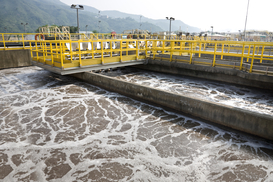In rural areas with little or no indoor plumbing, wastewater treatment can be as simple as the use of a pit latrine where wastes fall to a pit with lime or wood ash added periodically. The pit acts like a septic tank to break down the waste. Once the pit becomes full, the latrine can be moved and the pit planted with a tree to provide valuable future timber.
In more densely populated areas, waste treatment can be done using low cost earthen ponds. These ponds 3 - 5 feet in depth allow for biological decomposition of the waste and reducing in fecal coliforms. Even with a relatively short retention time of 3 - 5 days, this type of pond/lagoon system can substantially improve water quality down stream and eventually in the wells tapping into groundwater.
While the above simple solutions can be done with minimal investment or technical know-how, many residents in these areas need to be educated in the long term value of waste treatment. As we head into the 2015, I am going to put some effort providing information for use rural and developing area waste treatment that can be accomplished without electricity, extensive capital investment, or extensive technical knowledge.
Best wishes for the New Year!


 RSS Feed
RSS Feed